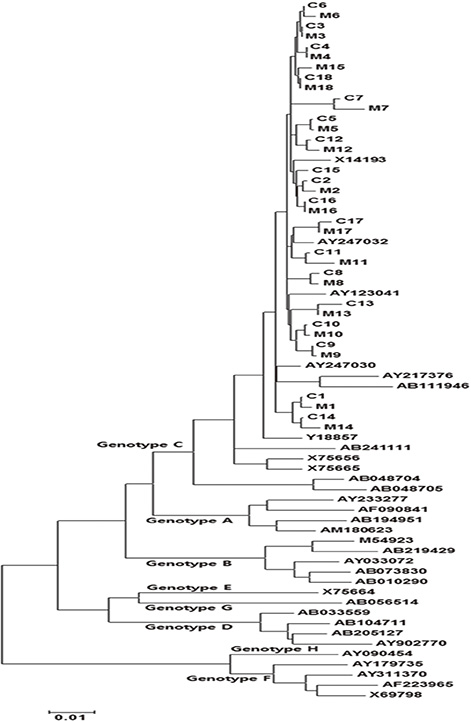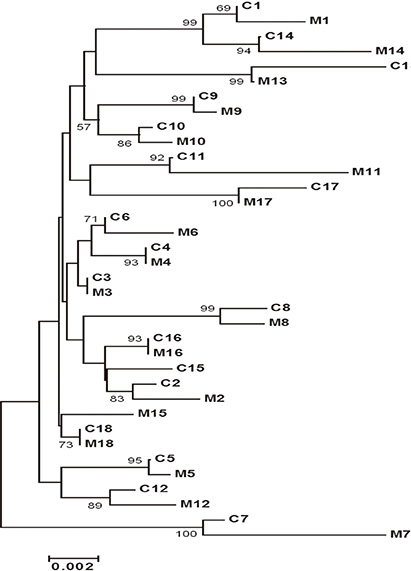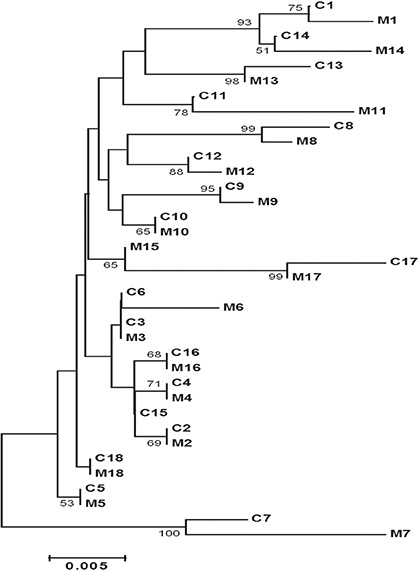J Korean Med Sci.
2014 Apr;29(4):564-569. 10.3346/jkms.2014.29.4.564.
Phylogenetic Analyses of HBV Pre-S/S Genes in Mother-Child Pairs with Long-Term Infection by Presumed Vertical Transmission
- Affiliations
-
- 1Department of Internal Medicine, Hallym University Medical Center, Seoul, Korea. mkjang@hallym.or.kr
- KMID: 1774463
- DOI: http://doi.org/10.3346/jkms.2014.29.4.564
Abstract
- Vertical transmission from mother to child, the main route of chronic hepatitis B virus (HBV) infection in the East Asia, is considered one of the most important predictors for the response to antiviral therapies as well as its complications such as cirrhosis and hepatocellular carcinoma. Therefore, it is critical in both etiologic and prognostic aspects to confirm whether or not chronic HBV infection is acquired vertically. This study investigated whether mother-to-child infection could be proved by the phylogenetic analyses of HBV pre-S/S genes ever since several decades have elapsed in mother-child pairs with presumed vertical transmission. The pre-S and S regions of HBVs were compared and analyzed phylogenetically in a total of 36 adults (18 mother-child pairs) with chronic HBV infection. All of the isolates of HBV were genotype C and serotype adr. The divergence between mothers and offsprings was 0 to 1.5%. Phylogenetic trees revealed that 17 of 18 pairs (94%) with presumed vertical transmission were grouped into the same cluster. Vertical transmission from mother to child could be strongly suggested even in adults with a history of several decades of HBV infection using the phylogenetic analyses of pre-S and S genes.
Keyword
MeSH Terms
-
Adult
Aged
DNA, Viral/analysis
Female
Genotype
Hepatitis B Surface Antigens/classification/*genetics
Hepatitis B virus/classification/*genetics/metabolism
Hepatitis B, Chronic/diagnosis/*virology
Humans
Infectious Disease Transmission, Vertical
Male
Middle Aged
Mothers
Phylogeny
Polymerase Chain Reaction
Sequence Analysis, DNA
Serotyping
Young Adult
DNA, Viral
Hepatitis B Surface Antigens
Figure
Reference
-
1. Beasley RP. Hepatitis B virus: the major etiology of hepatocellular carcinoma. Cancer. 1988; 61:1942–1956.2. Poland GA, Jacobson RM. Clinical practice: prevention of hepatitis B with the hepatitis B vaccine. N Engl J Med. 2004; 351:2832–2838.3. Jang MK, Choi DR, Lee JY, Moon HK, Lee JH, Kim SM, Kim KH, Park JY, Lee JH, Kim HY, et al. Responsiveness to interferon alpha in chronic hepatitis B by presumed vertical transmission. J Infect. 2005; 51:314–317.4. Kim HS, Kim HJ, Shin WG, Kim KH, Lee JH, Kim HY, Jang MK. Predictive factors for early HBeAg seroconversion in acute exacerbation of patients with HBeAg-positive chronic hepatitis B. Gastroenterology. 2009; 136:505–512.5. Vajro P, Migliaro F, Fontanella A, Orso G. Interferon: a meta-analysis of published studies in pediatric chronic hepatitis B. Acta Gastroenterol Belg. 1998; 61:219–223.6. Dumpis U, Holmes EC, Mendy M, Hill A, Thursz M, Hall A, Whittle H, Karayiannis P. Transmission of hepatitis B virus infection in Gambian families revealed by phylogenetic analysis. J Hepatol. 2001; 35:99–104.7. Tajiri H, Tanaka Y, Kagimoto S, Murakami J, Tokuhara D, Mizokami M. Molecular evidence of father-to-child transmission of hepatitis B virus. J Med Virol. 2007; 79:922–926.8. Thakur V, Kazim SN, Guptan RC, Malhotra V, Sarin SK. Molecular epidemiology and transmission of hepatitis B virus in close family contacts of HBV-related chronic liver disease patients. J Med Virol. 2003; 70:520–528.9. Lok AS, McMahon BJ. Chronic hepatitis B. Hepatology. 2007; 45:507–539.10. Bruix J, Sherman M. Practice Guidelines Committee, American Association for the Study of Liver Diseases. Management of hepatocellular carcinoma. Hepatology. 2005; 42:1208–1236.11. Jang JS, Kim HS, Kim HJ, Shin WG, Kim KH, Lee JH, Kim HY, Kim DJ, Lee MS, Park CK, et al. Association of concurrent hepatitis B surface antigen and antibody to hepatitis B surface antigen with hepatocellular carcinoma in chronic hepatitis B virus infection. J Med Virol. 2009; 81:1531–1538.12. Kim H, Jee YM, Song BC, Shin JW, Yang SH, Mun HS, Kim HJ, Oh EJ, Yoon JH, Kim YJ, et al. Molecular epidemiology of hepatitis B virus (HBV) genotypes and serotypes in patients with chronic HBV infection in Korea. Intervirology. 2007; 50:52–57.13. Hall TA. Bioedit: a user-friendly biological sequence alignment editor and analysis program for Windows 95/98NT. Nucleic Acids Symp Ser. 1999; 41:95–98.14. Larkin MA, Blackshields G, Brown NP, Chenna R, McGettigan PA, McWilliam H, Valentin F, Wallace IM, Wilm A, Lopez R, et al. Clustal W and Clustal X version 2.0. Bioinformatics. 2007; 23:2947–2948.15. Tamura K, Peterson D, Peterson N, Stecher G, Nei M, Kumar S. MEGA5: molecular evolutionary genetics analysis using maximum likelihood, evolutionary distance, and maximum parsimony methods. Mol Biol Evol. 2011; 28:2731–2739.16. Xu H, Peng M, Qing Y, Ling N, Lan Y, Liang Z, Cai D, Li Y, Ren H. A Quasi species of the pre-S/S gene and mutations of enhancer II/core promoter/pre-C in mothers and their children infected with hepatitis B virus via mother-to-infant transmission. J Infect Dis. 2006; 193:88–97.17. Cowie BC. Is there an optimal genetic target for molecular analysis of hepatitis B virus transmission? J Clin Microbiol. 2006; 44:3051.18. Datta S, Banerjee A, Chandra PK, Chowdhury A, Chakravarty R. Genotype, phylogenetic analysis, and transmission pattern of occult hepatitis B virus (HBV) infection in families of asymptomatic HBsAg carriers. J Med Virol. 2006; 78:53–59.19. Datta S, Banerjee A, Chandra PK, Chakravarty R. Selecting a genetic region for molecular analysis of hepatitis B virus transmission. J Clin Microbiol. 2007; 45:687.20. Friedt M, Gerner P, Wintermeyer P, Wirth S. Complete hepatitis B virus genome analysis in HBsAg positive mothers and their infants with fulminant hepatitis B. BMC Gastroenterol. 2004; 4:11.21. Song BC, Suh DJ, Lee HC, Chung YH, Lee YS. Hepatitis B e antigen seroconversion after lamivudine therapy is not durable in patients with chronic hepatitis B in Korea. Hepatology. 2000; 32:803–806.22. Lee SA, Kim KJ, Kim DW, Kim BJ. Male-specific W4P/R mutation in the pre-S1 region of hepatitis B virus, increasing the risk of progression of liver diseases in chronic patients. J Clin Microbiol. 2013; 51:3928–3936.23. Lee SA, Kim K, Kim H, Kim BJ. Nucleotide change of codon 182 in the surface gene of hepatitis B virus genotype C leading to truncated surface protein is associated with progression of liver diseases. J Hepatol. 2012; 56:63–69.24. Mun HS, Lee SA, Kim H, Hwang ES, Kook YH, Kim BJ. Novel F141L pre-S2 mutation in hepatitis B virus increases the risk of hepatocellular carcinoma in patients with chronic genotype C infections. J Virol. 2011; 85:123–132.25. Mun HS, Lee SA, Jee Y, Kim H, Park JH, Song BC, Yoon JH, Kim YJ, Lee HS, Hyun JW, et al. The prevalence of hepatitis B virus preS deletions occurring naturally in Korean patients infected chronically with genotype C. J Med Virol. 2008; 80:1189–1194.
- Full Text Links
- Actions
-
Cited
- CITED
-
- Close
- Share
- Similar articles
-
- Preventing Vertical Transmission of Hepatitis B virus
- Mutations in Hepatitis B Virus Precore and Core Promotor in Children with Chronic Hepatitis B Infection - Comparison Between Vertical and Non-vertical Transmission
- Chronic Hepatitis B in Pregnancy
- Elimination of Mother-to-Infant Transmission of Hepatitis B Virus: 35 Years of Experience
- Prevention and Management of Perinatal Major Infectious Diseases





